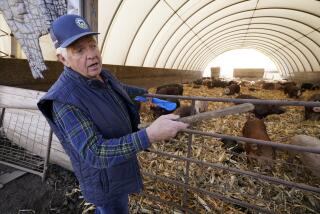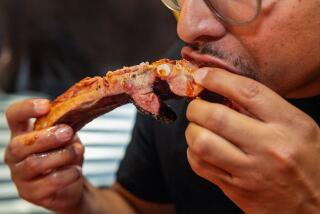Critics Skewer Pork Industry Over Pigs’ Confinement
- Share via
YORKVILLE, Ill. — Inside each of John Kellogg’s barns, long rows of grunting, snorting hogs fill every available space. The rows contain 100 animals--all pregnant or soon to be. Every animal faces the same direction in a scene of orderliness seldom associated with pigs.
The animals are not lining up by choice: Each stands inside a narrow metal crate. The pigs, which can reach 600 pounds, will spend much of their three or four years of adult life inside these crates, unable to turn around or even lie down fully because the stalls are just two feet wide. Only when caring for piglets will the sows live outside them for long, and then in different metal crates only slightly wider so they can recline to nurse.
This farm outside Chicago is by all accounts a model of pork industry efficiency, cleanliness and productivity, and the metal “gestation crates” are nothing unusual in the nation’s highly industrialized pork business. In fact, Kellogg’s stalls are the norm for the fast-growing industry, holding most of the 5 million sows that give birth to 100 million piglets yearly for the ham, bacon and pork chops on America’s plates.
But critics of this kind of intensive pig farming--from animal welfare activists to academic researchers and some big pork buyers--have been raising increasingly pointed and sometimes emotional objections to the crates. Some call the practice inherently cruel, some call it offensive because the confinement produces abnormal behaviors in relatively intelligent animals, and some worry it could endanger the pork industry if consumers begin to focus on it. In the name of progress, the critics ask, has the industry created a callous system that many people will find objectionable?
Those concerns are being translated into efforts to ban or curtail use of the crates. The European Union (EU), where animal welfare is a hot political issue, is close to adopting legislation that would phase out the stalls within 10 years--a decision that could have international trade implications. In Florida, American animal welfare groups are collecting signatures to place a similar statewide ban on the use of sow crates on next year’s ballot, as an opening shot in a national campaign here.
A ban on gestation crates is also part of a new American Humane Assn. certification process for pork (and other farm products) introduced last year. The voluntary program, which is approved by the Agriculture Department, allows pig producers willing to avoid controversial farm practices to place the group’s “Free Farmed” label on their meat and poultry.
But perhaps most telling, mainstream pork buyers are beginning to take note of the farm animal welfare issue. McDonald’s--with its finely tuned understanding of consumers, and especially the young--has assembled a task force to study whether pork suppliers should be required to find alternatives to sow crates. McDonald’s is supporting sow crate research at Purdue University, and company officials say they plan to have a policy by year’s end.
“I think the pork industry has to deal with the reality that they are raising sows in ways many people will find unacceptable,” said John McGlone of Texas Tech University, who has had discussions with McDonald’s about pig housing. He has been researching the health and behavior effects of the crates--which became common in the pork industry in the 1970s--and has designed experimental alternatives.
“I don’t believe the science entirely supports the position that crates cause undue stress on animals,” McGlone said. “But most consumers, when hit cold, will not think the crates are humane.”
Pig farmers believe they are being unfairly accused of ignoring the well-being of their animals. Industry officials say the individual stalls contribute to animal welfare by ensuring that all sows are fed, and by preventing otherwise frequent fighting among animals. What’s more, they say, crates keep prices low by allowing many sows to be raised, watched and controlled in relatively small areas, and they improve food safety by keeping animals cleaner.
“Farmers treat their animals well because that’s just good business,” said Paul Sundberg, a veterinarian and National Pork Producers Council vice president. “The key to sow welfare isn’t whether they are kept in individual crates or group housing, but whether the system used is well managed.”
Sundberg contended that “science tells us that she [a sow] doesn’t even seem to know that she can’t turn. . . . She wants to eat and feel safe, and she can do that very well in individual stalls.”
But Sundberg acknowledged there is active scientific dispute over the effects on sows--although he also complained some of the protest comes from vegetarians who don’t want people to eat meat at all.
The crates are generally about 7 feet long and 2 feet wide. One influential University of Illinois study concluded in 1988 that large pigs need stalls 10 to 12 inches wider, but industry observers say the trend now is toward narrower stalls. The stall floors are often made of concrete, with slats that allow waste to be collected below.
Kellogg, the Illinois farmer, said that years in the pork business have taught him that sow stalls do not compromise animal welfare. Having spent millions of dollars to create his highly productive sow farm (he has 1,200 sows, which produce 23,000 piglets yearly), he sees no reason to change systems to outdoor or group housing.
“Our system allows low labor costs per animal, allows us to watch each animal well, and it results in a very safe product,” he said. “I don’t see any problem here.”
Researchers have generally not found that sows in crates have elevated levels of stress hormones, suggesting that their overall health (other than reduced muscle and bone mass) is not being compromised. But sows in stalls tend to display behavior often associated with animals experiencing extreme boredom or stress. They spend significant time biting the bars in front of them, chewing without food and pressing their water bottles obsessively. There’s no rooting in dirt, which makes up much of instinctive pig behavior.
In a report by veterinarians that led to the pending EU legislation phasing out sow stalls, the authors concluded that abnormal behaviors “develop when the animal is severely or chronically frustrated. Hence their development indicates that the animal is having difficulty in coping and its welfare is poor.”
The U.S. industry and its critics are not proposing larger stalls to resolve the issue. Instead, some pork producers and Texas Tech University have experimented with outdoor and group systems for raising sows that are as effective and productive as the stalls, McGlone said. On his research farm outside Lubbock, sows and their piglets live in fields, with small metal huts for protection.
“The industry may not think that crates are a problem, but what if consumers disagree?” McGlone said. “It’s time to seriously look at the alternatives.”
More to Read
Sign up for Essential California
The most important California stories and recommendations in your inbox every morning.
You may occasionally receive promotional content from the Los Angeles Times.













